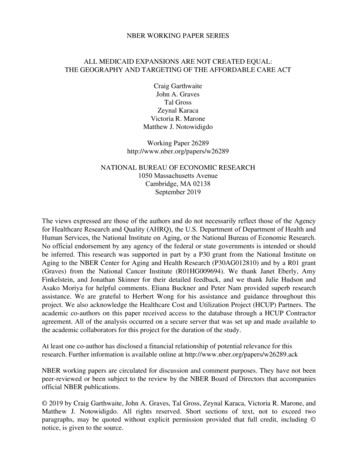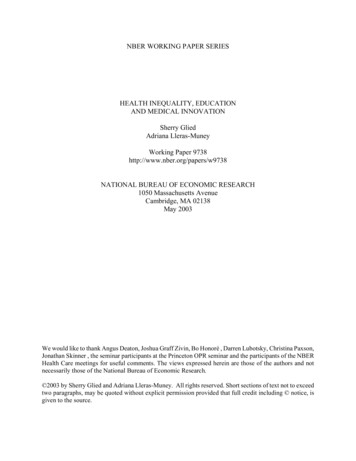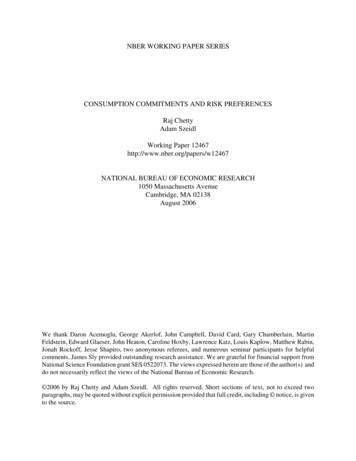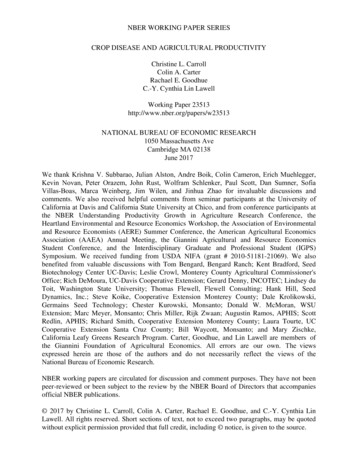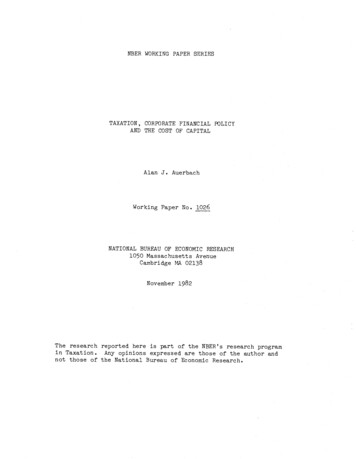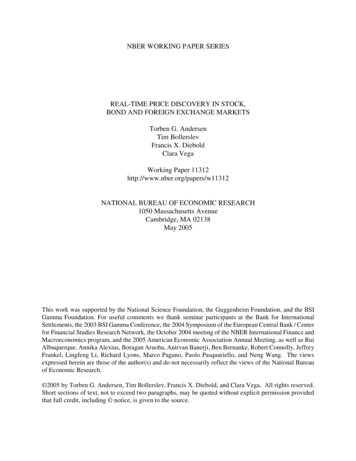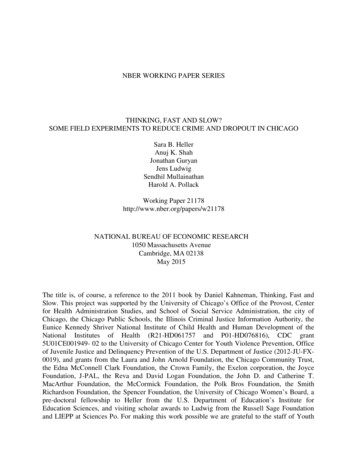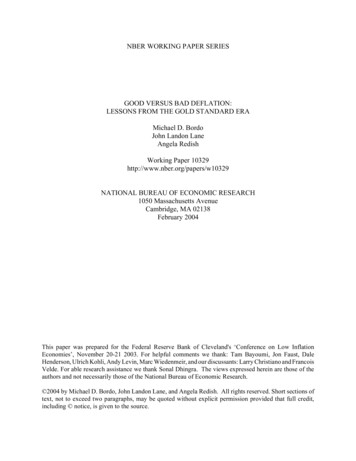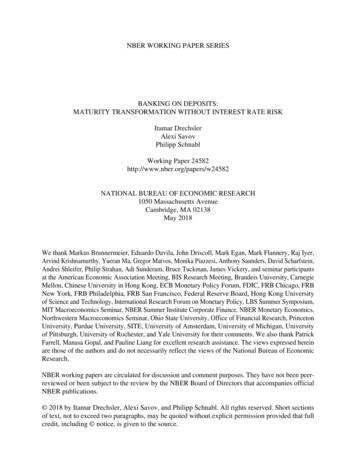
Transcription
NBER WORKING PAPER SERIESCONSTRAINTS ON THE LEVEL ANDEFFICIENT USE OF LABOR IN JAPANHiroshi OnoMarcus E. RebickWorking Paper 9484http://www.nber.org/papers/w9484NATIONAL BUREAU OF ECONOMIC RESEARCH1050 Massachusetts AvenueCambridge, MA 02138February 2003The authors wish to thank Masayuki Kakuho and Hiromi Murata of Recruit Works Institute, Minoru Ito ofthe Japan Institute of Labor, Koichiro Masuda, Fumio Ohtake, Kazumi Ota, Yasuo Takahashi, andparticipants in the March 2002 NBER-CEPR-EIJS conference and the Oxford Labor Economics Seminar.All omissions and errors are of course our own. A slightly different version of this paper appears as SSE/EFIWorking Paper Series in Economics and Finance 500. The views expressed herein are those of the authorsand not necessarily those of the National Bureau of Economic Research. 2003 by Hiroshi Ono and Marcus E. Rebick. All rights reserved. Short sections of text not to exceed twoparagraphs, may be quoted without explicit permission provided that full credit including notice, is given tothe source.
Constraints on the Level and Efficient Use of Labor in JapanHiroshi Ono and Marcus E. RebickNBER Working Paper No. 9484February 2003JEL No. J16, J24, J31, J60, J68ABSTRACTWe examine a number of personnel practices, laws and regulations that lower the supply of laborin the Japanese economy. Broadly speaking, there are two kinds of impediments, those that restrictthe movement of labor between firms, and those that discourage women from participating to agreater extent. Using other OECD countries and especially the United States as a benchmark, weestimate that removal of these barriers would increase the productive labor supply in Japan by some13 to 18 percent and thus could raise the potential growth rate of the Japanese economy by roughly1% per annum over a ten-year period.Hiroshi OnoMark RebickThe European Institute of Japanese StudiesNissan Institute of Japanese StudiesStockholm School of Economics27 Winchester RoadP.O. Box 6501Oxford, OX2 6NAS-113 83, Stockholm, SWEDENUnited ute.oxford.ac.uk
Japanese labor market institutions have been given substantial credit forJapan’s enviable growth performance after World War II. The personnel managementsystem – with its strong job protection, enterprise-based unionism, and intensiveon-the-job training – is especially seen as a factor that allowed Japan to utilizeimported technology so rapidly and successfully. High levels of training, along withgroup-oriented activities, have also been linked to the high quality of the Japanesegoods that reached export markets in the 1970s and 1980s. Indeed, many Japaneseworkplace practices such as quality-control circles have been adopted to good effectin the United States and Europe. On the macroeconomic side, the coordinated butdecentralized bargaining system is seen as providing for the wage flexibility thatallowed Japan to adjust to supply shocks, such as the two oil crises, more rapidlythan most other OECD economies. Finally, the egalitarian nature of the compensationsystem has been credited with providing the widespread prosperity that underliesdomestic demand.The prolonged slowdown of the 1990s has led many to question whether theinstitutions that were appropriate for the past are as wholesome for the health ofthe contemporary and future economy. In particular, the rise in the unemployment ratesince 1998 from around 3% to almost 6% has changed views about the macroeconomic roleplayed by the labor market.This disillusionment can be quickly summarized. Strong job protection makesit difficult for companies to restructure their activities effectively in responseto the changing external environment. This means companies are less likely to improvetheir balance sheets. A poorly developed external labor market impedes movement ofexperienced and knowledgeable employees to companies where they might be more valuable.The government, lacking confidence in the external labor market to absorb theunemployed, may have been reluctant to push for more drastic resolution of the baddebt problem that hampers the financial system. Under conditions of weak demand,the coordinated bargaining system makes it difficult for employees to increase theirincomes and thereby may reduce domestic demand. Wage restraint is contributing tothe deflation that currently is making difficulties for the effective use of monetarypolicy to revive economic growth. The aging of the work force makes it difficult tomaintain a system where rewards are delayed and provided through promotion.In this paper we address impediments to growth of the labor supply that areaffecting the economy. Broadly, these are barriers to inter-firm mobility for careeremployees, especially older men, and the difficulty women face in developingmeaningful careers after taking time off to raise children. The latter depressesthe labor force participation of women, especially the middle-aged who have higheducational attainment. Both of these issues are closely tied to the Japanesepersonnel management system and the legal framework that supports it.A third impediment to growth on the labor supply side is the reluctance toaccept large numbers of immigrants into Japan. The outlook is that Japan will continuewith its existing policies in the short- to medium- run, and we do not consider theissue. We also do not address the way in which the unemployment benefit system mayinduce individuals to remain unemployed, or how retirement benefits may encourageearlier retirement. With respect to the unemployment rate and participation rateof those over 60, Japan is doing as well, if not better, at using potential laborresources than other OECD countries. It should be noted that the institutionalfeatures of the economy that we view as impediments would be significantly lessproblematic if the economy was growing at the rates seen through the 1980s. If growth1
could be restored to 1980s levels through a surge in consumer and investment demand,much of the estimated losses to labor input might well be eliminated. However, thatis unlikely to happen.In the next section we provide an outline of the state of Japanese labor in2001, focusing on the extent to which institutions long seen as characteristic ofthe Japanese labor market have stayed the same or been changing. Next, labor law andits consequences are discussed. We then look at impediments to the mobility of careeremployees (primarily men) that may be affecting growth. Reasons why female laborforce participation may be lower than levels seen in the United States are thenexamined. A quantitative perspective of the barriers is presented, including theiroverall implications for economic growth. The role of government policy in removingbarriers is taken up, and we outline some areas in need of further research.1The Employment SystemJapanese labor markets and institutions have been affected by the slump in growththat began in the 1990s, but many of the main features remain largely intact. Widelynoted aspects of the “Japanese model” such as enterprise-based unionism, lowinter-firm mobility, low unemployment, compensation within gender groups that ishighly determined by age and seniority, large gender gaps in pay and promotions, andwidespread use of mandatory retirement systems have not dissolved in the face of theslowdown, despite press reports.1.1 Evidence of Only Minor ChangeEvidence that the system has seen only minor change includes the following sevenpoints.1Unions remain enterprise based, although union density has fallen steadilyfrom around 35% at the time of the first oil shock (1973) to 21% in 2000.2Job tenure for full-time regular employees remains high (Chuma 1997) and mayeven be increasing for some age groups.3Inter-firm mobility rates remain virtually unchanged (Rebick 2000) althoughthe number of employees forced to move because of bankruptcies has risen since theAsian economic crisis of 1998.4The 5.4% unemployment rate in May 2002, although high by Japanese standards,remains lower than the OECD average of 6.9% (OECD standardized rates).5Although performance- and results-related pay are becoming more importantcomponents of compensation arrangements, there is still a close relationship betweenage (and, to a lesser extent, seniority) and pay. Japanese age-wage profiles aresteep mainly because blue-collar workers as well as white-collar workers see largeincreases in pay with age and seniority. With the exception of the managerial classof employees, the variance of pay within age groups remains stable (Genda and Rebick2000). All of this is testimony to the continuing presence of enterprise unions andthe influence of large, unionized firms on wage-setting practices outside theorganized sector.6The gender pay gap has narrowed for full-time employees (especially the young),but the gap in hourly pay between part-time female workers and male full-time employeesremains large. Because some 40% of women work part-time, the overall gender gap remainslarge. Among eight OECD countries including Korea, only in Japan is gender – rather2
than occupation, age, or industry – the most important determinant of wages(Tachibanaki 1998).7Japan has relatively few women in senior management or director positionscompared with the United States or United Kingdom.1.2 Examples of ChangeIn spite of these observations, the Japanese model is evolving. Further, most of thechanges appear to be permanent, rather than temporary accommodations to economicconditions or the need for restructuring.1The proportion of individuals who are part-time or contract workers isincreasing. In particular the percentage of employees working part-time has beenrising steadily since the 1960s, reaching highs of 39% of women and 13% of men in1999 (OECD 2001). The number of temporary agency workers remains low at about 1%of the work force, but has been increasing rapidly with liberalization of the lawsregulating agency work.2There has been a decline in the family-based enterprise sector. Some womenwho would have been family workers, and men who would have become self-employed aftermandatory retirement, are now in the part-time employee labor force. Although someof this trend may be due to small businesses suffering during the 1990s, much of itis due to other aspects of the fundamental restructuring of the economy that is takingplace.3Managerial compensation is becoming much more sensitive to various measuresof performance. This is shown not only by surveys across companies, but also by thefact that the variance of pay of middle-aged men with higher education degrees hasbeen increasing since the mid 1980s (Genda and Rebick 2000).4Attitudes are changing, especially among young people. Although the ratesof separation for young workers have not increased much, most young employees saythat they expect to change jobs before mandatory retirement. Cohort effects notwithstanding (Ohtake and Inoki 1997), young workers are quitting jobs at an increasingrate despite the poor state of the economy. In 1999, 32% of university graduatesand 47% of high-school graduates quit their first jobs within three years, bothincreases since 1996 (MOL 1999).5There is an increasing level of part-time work among the young. Oftenreferred to as "freeters," they may be finding it difficult to find desirable full-timejobs in the current economic climate (Genda 2001). On the other hand, because ofgreater affluence, they may feel less pressured into taking jobs they don't reallywant.2Worker ProtectionThe most obvious problem facing companies burdened with redundant workers is thedifficulty in shedding workers. There is long-standing agreement between managementand labor in Japan that allows management to move workers around in the company (oreven to loan workers to other companies) in return for a guarantee of employment untilmandatory retirement age (Gordon 1985, 1998). Since the late 1970s this has beenaltered somewhat: employees might be sent to other companies prior to mandatoryretirement provided that the guarantee of employment still holds. In most cases,the original company ensures there are no financial losses to those transferred,3
making supplemental payments to workers if necessary. Although this is seen as acommitment by management to labor, which might be upheld in order to maintain thereputation of the employer (and industrial peace), it is reinforced by Japanese caselaw. (The remainder of this section leans heavily on Chuma 1998.)Japanese labor law does not, by statute, provide guarantees of continuedemployment to employees, except that employers must give 30 days notice of dismissals.The Japanese constitution, however, enshrines the individual's right to work (Article27) and the right to a minimum standard of “wholesome and cultured living” (Article25). On this basis, Japanese courts have interpreted the law to impose four mainstandards on employers wishing to dismiss workers. The employer must show that:1 It is under severe duress, such as facing possible bankruptcy and redundanciesare unavoidable.2 It has made efforts to avoid redundancies by taking measures such as cuttingovertime, hiring freezes, transfers, seconding workers to other companies, orseeking voluntary retirements.3 It has consulted with its labor unions and employees.4 It has a rational procedure for selecting those to be dismissed.This case law developed in the 1950s in reaction to the widespread dismissalsthat followed implementation of the disinflationary Dodge Line of 1949-50 and thenumerous industrial disputes that followed. The courts were concerned aboutdismissals being used as a way of undermining labor union strength, and the fourconditions were aimed primarily at establishing what constituted unfair laborpractice under postwar labor laws. The courts also established that redress forviolation of these principles is not only that the fired worker must be compensated,but that the worker must be reinstated with back pay. Again, this was to act as adeterrent to labor practices deemed unfair.The rulings had an effect: in 1975, at the peak of post-oil shock dismissals,the proportion of separations that were “at the employer’s will” stood at only10%, compared to 21% in 1954, and through the late 1970s firms in general took everyaction to avoid dismissals (Chuma 1998). The case law was further strengthenedthrough rulings in the late 1970s, at a time when a number of court cases examineddismissals for the purpose of labor adjustment during the downturn of the mid 1970s.In the 1970s and after, protection of workers from dismissals was extended to temporaryand fixed-contract workers who had been repeatedly rehired after their contractexpired and even to workers in the first, probationary year of employment.Until 1998 the Labor Standards Law limited fixed-term contracts to one yearor less. This was intended to force employers to offer indefinite-period contractsto employees. After the 1998 revision, the law allows contracts of up to three years,but only in the case where the employee is over 60, or is in a specialized occupation,or under other restricted circumstances determined by the Ministry of Health, Laborand Welfare (MHLW). Further, such a contract is not renewable, except for one year(Yamakawa 1998). This is a considerable restriction, and has been heavily criticized(Ohtake 2001, Yashiro 1999).Since 1999 there have been a number of court rulings thathave relaxed and even, in at least one case, dispensed with the framework of the fourconditions, but it is still too early to know what overall effect these rulings willhave (Yamakawa and Araki 2001).2.1ConsequencesOne problem with the level of job protection provided by dismissal case law has been4
the reluctance of employers to hire employees that they are not sure they wish tokeep indefinitely. There also are negative externalities (Yashiro 1999). We laterdeal with one of the more serious of these: the lack of a well-developed externallabor market and the information problems that result.Another effect of current law is that it encourages companies to seekgovernment help in the form of subsidies, protection from competition, and protectionfrom creditors. Although labor case law was not responsible for this action, it ispart of a general approach that provides economic security through employers ratherthan directly from the state or private insurance provision (Noguchi 1995). Thismay come at the expense of growth in total factor productivity. For example, Hayashiand Prescott (2002) note that TFP growth was exceptionally low at 0.8% per annum during1978-83 when the government took action to subsidize and otherwise support industriesthat were in need of restructuring and firms endeavored to avoid dismissals.Although arguments can be made for worker protection from the viewpoint ofeconomic efficiency, there is little rationale for imposing a penalty whereby workersmust be reinstated with back pay. Chuma (1998) argues that it would be better tosimply impose a cash penalty that employers should pay workers who have been dismissedin violation of the conditions. He also suggests that courts may not be in the bestposition to evaluate the financial concerns of the company and that if the "severeduress" condition is imposed too stringently it may compromise the survival of thefirm over the long run.If a firm can no longer produce competitively, its human capital may havelost value regardless of what the firm is paying the employee. The benefits of workerprotection may be quickly outweighed by the costs when there is a widespread dropin the value of some kinds of firm-specific human-capital.3Barriers to Mobility Between FirmsThere are many barriers to mobility in the Japanese labor market. Table 1 gives ussome indication of the problems from the point of view of employees, based on a surveyby Recruit, an employment service. Here, individuals who wanted to change jobs wereasked why they found it difficult to do so. Of course, there also are correspondingissues on the employer side of the labor market. We analyze all of these beginningwith information problems, skill mismatch, and lack of pension portability. Senioritypay and age-based discrimination are then taken up, followed by differentials in payby firm size and egalitarian pay norms. Job protection, the result of both law andfirms' employment practices, is analyzed as a cause of both excess workers withinfirms and skill mismatch.3.1 Information ProblemsA long-standing problem in the Japanese labor market concerns the lack of availableemployment information. Commonly, workers do not know exactly (in terms of qualityor quantity) what skills they have, and employers are unclear about the skills theyneed. That is, there has been a symmetric lack of information, and this is almostcertainly due to the poor development of the external labor market in an economy withoverall low mobility. “Better information for job seekers” has been a recurrentslogan in a situation where job postings tend to be ambiguous and crucial informationsuch as job description and required skills are lacking (JIL 1998).5
Employment information can be categorized into extensive information, whichconsists of information available to all job-seekers such as firm size and wages,and intensive information, which is more likely to be insider in nature such as worknorms and work atmosphere of the employer (Rees 1966).Access to intensiveinformation is a benefit insofar as it improves the quality of the job match, andsubsequently leads to higher rewards and better job satisfaction (Granovetter 1974,reporting a study of white-collar males in Boston). Watanabe (1992) explains thatworkers are more likely to obtain intensive information through acquaintances orformer employers. According to Recruit's 2001 survey, 41% of job seekers gatheredemployment information through “contacts with friends, family and former employers”and 72% of those found jobs through this channel (equal to 30% of all those who foundjobs). In Granovetter's study, 56% used contacts.A labor market that favors informal job-search methods disfavors job-seekerswho are not endowed with network ties or otherwise must seek re-employment throughformal means. Workers seeking employment through direct applications throughemployment agencies experience considerable hardship. This includes longer durationof job-search and a poor quality of match (JIL 1998). This is not a problem peculiarto Japan.In a society where a market for job-changers is only just evolving andone-fifth of worker surveyed said they “do not know how to look for jobs” it isnot surprising that firms specialized in headhunting and re-employment services aregrowing rapidly. Human resource firms are focusing on the information mismatchbetween buyers and sellers of labor. Their services include helping employers graspwhich skills are needed, and helping job-seekers identify what types of skills theyhave and the options available to them. The government is gradually deregulatingthe market for private employment services, including temporary employment agencies,through revision of the Dispatched Employees Law. All this may lead to improvement.Access to privileged information from social networks may not be limited toemployment information. The quantity and quality of social resources are determinednot only by the breadth and depth of an individual’s network of acquaintances, butalso by virtue of belonging to a particular organization. Establishing importantconnections with business partners, and gaining trust and reputation within the firm,are important forms of social resources that workers acquire through their jobs.However, in most cases, such resources are lost if a worker relocates to a differentestablishment. Social resources acquired through business can be a benefit thatfacilitates workers’ upward mobility within firms, but it can also be an impedimentto inter-firm mobility as workers fear that they “will lose personal contactsestablished through work.”3.2 Skill MismatchSkill mismatch is a problem related to information availability, and it is ofincreasing concern in Japan. A survey of OECD economies reports that the Beveridgecurve (which graphs unemployment rates against vacancies) has been shifting outwardin Japan since the 1970s (Nickell and others 2001) and this trend has clearlyaccelerated in the late 1990s (Genda and Rebick 2000). This implies more jobs areavailable for any given unemployment rate, and that suggests there may be an increasingmismatch of skills. A survey of businesses and job seekers found that the level ofvacancies (690,000) and applicants (740,000) across 60 occupational categories werefairly close, but within categories the the ratio of vacancies to applicants ranged6
from 9.95 to 0.05 (METI-Recruit 2001).A lack of necessary qualifications of job applicants, especially in some ofthe more specialized occupations such as IT-related work, also is highlighted in theMETI-Recruit study. It is clear information flows must be improved in several ways.Firms need to convey to those who provide training just what skills they need, andthat information must also reach those seeking training or needing it as a resultof being laid-off. Outplacement departments could do a better job as regards the latter.Public funds for retraining are offered to both companies and individuals, are andthere proposals to increase the levels.3.3 Lack of Pension PortabilityClosely related to the problem of seniority-based pay (taken up later) is the lackof portability of private, firm-based pensions. Japan implemented the equivalentof the US 401(k)-type defined-contribution plans in October 2001. Prior to this,there were no tax advantages to saving outside of the defined-benefit plans offeredby firms.Firm-based pensions take a number of different forms and can make lump-sumpayments or provide annuities after retirement, but they share the characteristicsof offering benefits based on years of service and final base salary. A recipientwith 35 years tenure typically gets two to four years of base pay (that is, notincluding semi-annual bonuses), with the higher rates going to the better-educatedemployees of large firms (MOL 2000b). Portability problems arise because payoutsoften are reduced more than proportionately if an employee leaves before mandatoryretirement. At the same time, an individual with low tenure at mandatory retirement(due to switching firms) may suffer from a more than proportional reduction in benefits.In other words, the likely losses in earnings from a move extend to losses in pensions.Ichinose (2001) uses pension tables to compute the pension losses that wouldbe experienced by individuals who leave a large firm (more than 1000 employees) andmove to a smaller firm at lower pay, which is the most common pattern. The lossesare computed assuming that an individual is paid the average for the firm size andaccording to tenure. Pension losses can amount to 10 million to 20 million froman average pension of 35 million, depending on age at separation. The younger theage, the greater the loss. For this reason, firms, especially large firms, offeradditional lump-sum payments to individuals who leave under early retirement plans.The additional payments – typically between 5 million and 10 million – cover some,but not all of the losses in pension value. In comparison to the overall losses ofup to 100 million that may be realized by workers who lose their jobs at large firmsat age 40, these are not large quantities, but as suggested by the responses in Table1, have some influence on behavior.4Seniority and Pay StructureThere are significant tenure effects on earnings from seniority in the Japaneseworkplace. The work of Koike (1988), Hashimoto and Raisian (1985) and Mincer andHiguchi (1988) drew attention to the importance of on-the-job training and thedevelopment of firm-specific human capital for Japanese men. Along with the casestudies and direct surveys of Koike, the latter two papers highlighted the apparentlylarge increase in earnings with tenure (seniority) in Japan compared to the United7
States.Work by Ohtake (1998) and others using cross-section microdata has, however,modified this view substantially. First, Ohtake finds that the return to tenure wassmaller than had earlier been reported, even in the past. Second, he shows that thereturns to tenure fell between 1980 and 1992, while rising in the United States. Thecross-sectional data suggest that the increase in earnings attributable to tenureis 1% to 2% per year in Japan, still somewhat higher than in the United States. Thisis mainly, but not entirely, due to the fact that seniority has a much larger effecton the earnings of Japanese blue-collar workers than their US counterparts.Although there may well be an explanation in terms of firm-specific humancapital to support the high returns to tenure in Japan, there are other views of thispattern that suggest that it may be a compensation policy developed in the 1920s andstrengthened in the immediate postwar period to motivate workers and to provide forbasic needs. In this view, the returns to seniority can be reduced through managerialreform without having any adverse effect on productivity, if pay-for-performancesystems are introduced. This seems to be what is taking place, albeit at a slow pace(Rebick 2001). If the returns to seniority were further reduced, this shouldnaturally raise the rate of mobility and also lessen the motivation of the courtsto maintain such high standards of legal protection. Some of the arguments used bythe courts have made reference to the need for worker protection given the natureof the Japanese employment system, including the pay accorded to seniority (Chuma1998).What makes the tenure effect so important for Japan, is that average tenureis higher in Japan than in most other OECD countries for all age categories, Italybeing a notable exception. As a result, middle-aged Japanese employees stand to losemore by leaving their firm than their counterparts in most other countries. Thisis particularly important for the higher-paid employees of large Japanese firms whohave almost double the median tenure of those in smaller firms (Ohtake 1998, Table4.7). The losses in earnings experienced by workers who leave firms after many yearshave an effect on mobility because they will increase resistance to the employer byunions or workers who know they have the support of the legal system.4.1 Age-Based DiscriminationA consequence of the long-term employment and seniority systems is that Japanese firmsimpose age limits when recruiting and hiring. Workers exceeding the age limit ofthe jobs posted continues to be the most common reason for workers not changing jobs(Recruit 2001a, JIL 2001c). For this reason, here we pay special attention to theovert age-based discrimination in Japan's labor market.Over 90% of Japanese firms impose age restrictions, generally 35 to 40, ontheir job openings. There is little variation across industry, firm size, and citysize (JIL 2001a). There are many reasons why firms impose age limits, but theyprimarily concern how older workers do not fit into the firm’s current employmentsystem (Table 2). These reasons make sense in light of the previous discussion.Because of the prevailing norm of long-term employment, there is still a stigmaattached to older or mid-career job seekers and firms often view them as “hard tohandle” or as “unable to adapt well to the corporate culture.” It is also likelythat many individuals who have lost jobs in other companies are simply not as able,so a potential employers’ view that they don't adapt well applied in their formercompany. The hesitancy to hire mid-career workers is partly rooted in the notion8
of equity. Indeed, from Table 2 we can infer that the reason for age restrictionsis less because of the “re
Constraints on the Level and Efficient Use of Labor in Japan Hiroshi Ono and Marcus E. Rebick NBER Working Paper No. 9484 February 2003 JEL No. J16, J24, J31, J60, J68 . 2 Job tenure for full-time regular employees remains high (Chuma 1997) and may even be increasing for some age groups. 3 Inter-firm mobility rates remain virtually unchanged .
